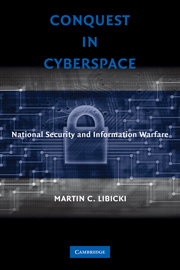Book contents
- Frontmatter
- Contents
- List of Figures
- Acknowledgments
- 1 Introduction
- 2 Hostile Conquest as Information Warfare
- 3 Information Warfare as Noise
- 4 Can Information Warfare Be Strategic?
- 5 Information Warfare Against Command and Control
- 6 Friendly Conquest in Cyberspace
- 7 Friendly Conquest Using Global Systems
- 8 Retail Conquest in Cyberspace
- 9 From Intimacy, Vulnerability
- 10 Talking Conquest in Cyberspace
- 11 Managing Conquest in Cyberspace
- Appendix A Why Cyberspace Is Likely to Gain Consequence
- Index
11 - Managing Conquest in Cyberspace
Published online by Cambridge University Press: 05 June 2012
- Frontmatter
- Contents
- List of Figures
- Acknowledgments
- 1 Introduction
- 2 Hostile Conquest as Information Warfare
- 3 Information Warfare as Noise
- 4 Can Information Warfare Be Strategic?
- 5 Information Warfare Against Command and Control
- 6 Friendly Conquest in Cyberspace
- 7 Friendly Conquest Using Global Systems
- 8 Retail Conquest in Cyberspace
- 9 From Intimacy, Vulnerability
- 10 Talking Conquest in Cyberspace
- 11 Managing Conquest in Cyberspace
- Appendix A Why Cyberspace Is Likely to Gain Consequence
- Index
Summary
Cyberspace lends itself to policy questions of the sort applicable to other media. How can one best use power in this medium to do unto others? How can one best maneuver in this medium to prevent being done unto? Insofar as conquest in cyberspace has hostile and friendly vectors, these two policy questions turn out to be four:
How can the method of hostile conquest be used wisely?
How can countries ensure that others cannot conquer those parts of cyberspace they deem worth protecting?
How can a country best pursue its interests by exercising friendly influence through cyberspace?
How can a country best resist the friendly accretion of unwarranted influence in cyberspace by others?
The first question can be interpreted as one of command and control, strategies, operations, techniques, and tools. Information warfare is not without its conceptual problems, such as the ability to define legitimate targets – but so are other domains.
The second question requires first determining what it is that must be defended and why. No one doubts that it is a government responsibility to defend Pittsburgh against Iranian missiles or chemical clouds; the good burghers are not expected to take this upon themselves. But, in cyberspace there are limits on what governments should be expected to contribute the common defense.
- Type
- Chapter
- Information
- Conquest in CyberspaceNational Security and Information Warfare, pp. 256 - 290Publisher: Cambridge University PressPrint publication year: 2007



